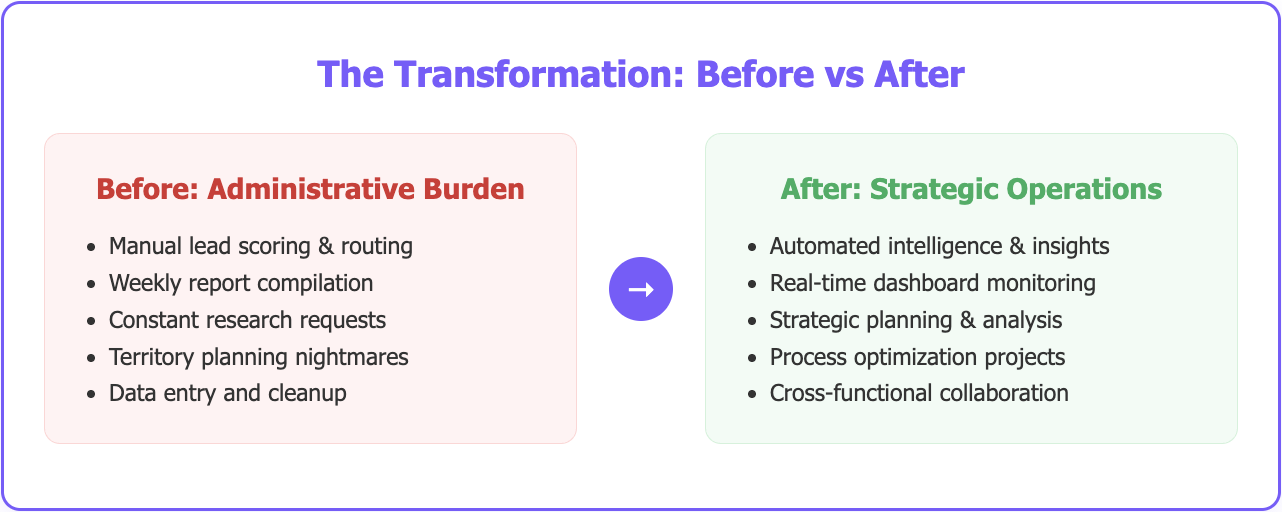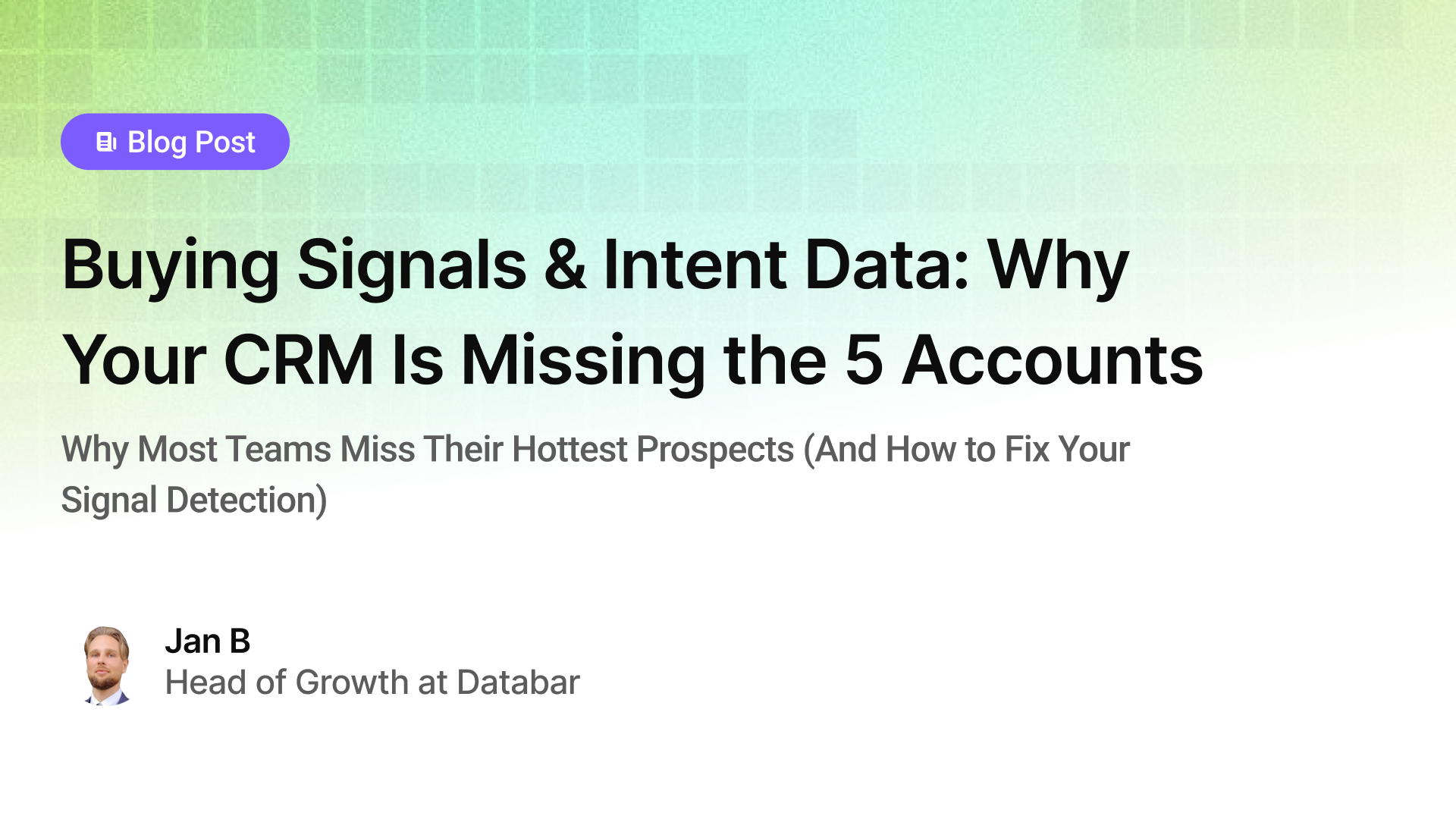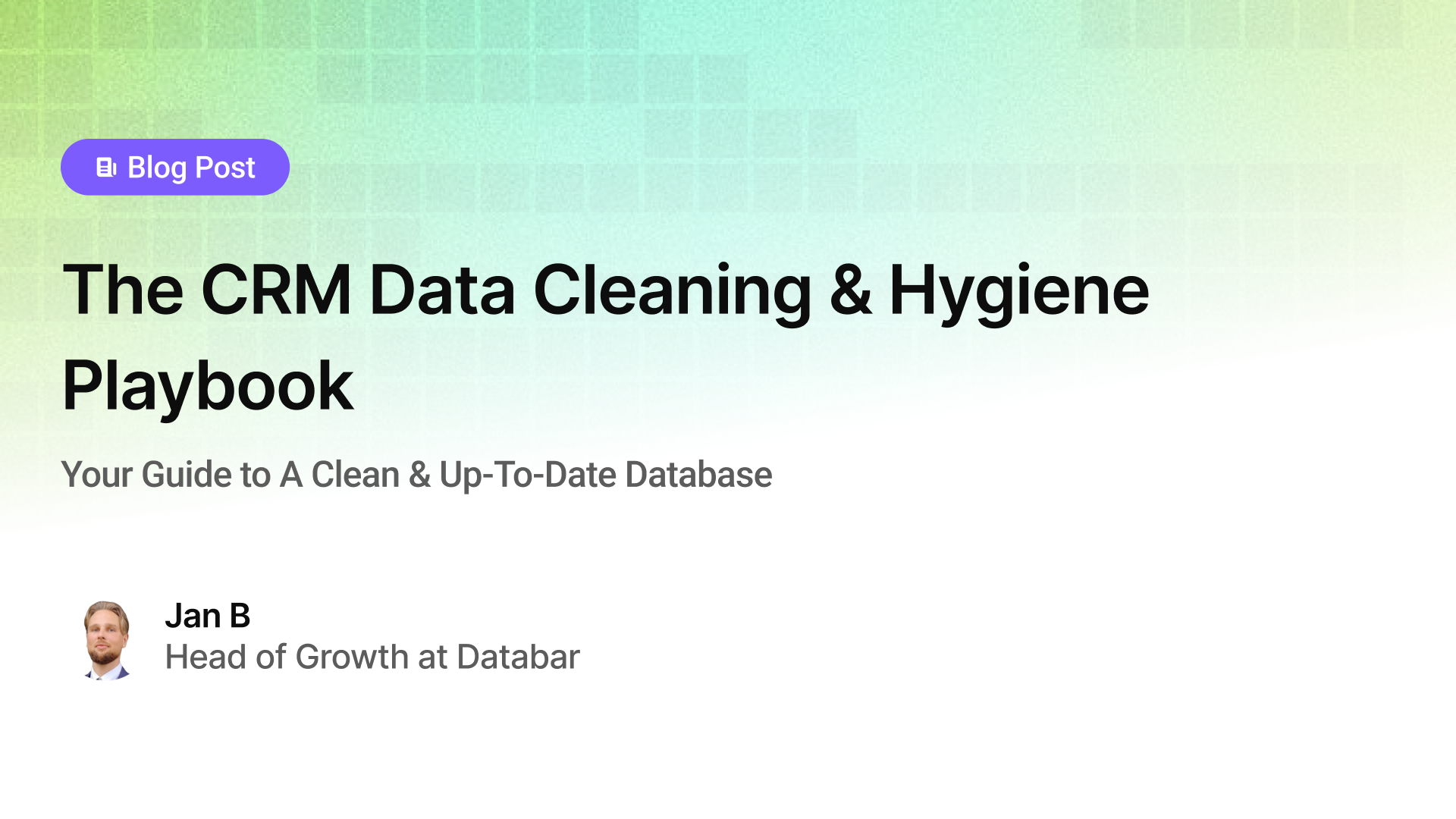Sales Operations: How to Build and Scale Your Operations Without Adding Headcount
Build scalable sales operations through automation, data intelligence, and strategic processes — without expanding your team.
Blogby JanAugust 07, 2025

Most sales operations teams face a familiar problem: revenue targets keep climbing while headcount budgets stay flat. The pipeline grows, the workload increases, but the resources remain the same. Traditional approaches suggest hiring more people to handle the volume, but this creates as many problems as it solves.
Organizations that successfully scale their sales operations without expanding teams have identified a different approach. Instead of adding more people to handle inefficient processes, they've redesigned the processes themselves. The constraint isn't team size — it's how work gets done.
Why Your Current Approach Isn't Working
Let's be honest about what's really happening in your sales ops world right now. You're probably spending your days like this:
8:00 AM - Check overnight leads, manually score and route them to reps
9:30 AM - Update pipeline reports by pulling data from three different systems
11:00 AM - Research prospect companies for the afternoon's discovery calls
1:00 PM - Create custom pricing for two deals stuck in legal review
3:00 PM - Track down missing information for forecast call
4:30 PM - Answer rep questions about territory assignments and quota calculations
5:30 PM - Realize you haven't touched any strategic work all day
This isn't sales operations. This is administrative quicksand.
The math is brutal. A typical sales ops professional spends 65-70% of their time on routine tasks that add minimal strategic value. Meanwhile, high-impact activities like process optimization, strategic analysis, and cross-functional collaboration get pushed to "when I have time" (which never comes).
But here's what most people miss: hiring more people makes this worse, not better. Each new team member adds communication overhead, coordination complexity, and management burden. You end up with more people doing the same inefficient work.

What Works Instead
The organizations winning at sales ops scaling have figured out a different game entirely. Instead of scaling through people, they scale through intelligence and automation.
Take a mid-market software company we worked with. Their sales ops team of three was drowning trying to support 25 reps across two product lines. Leadership wanted to hire two more ops people to "keep up with growth."
Instead, they spent six months rebuilding their operations around three core principles:
- Automate the routine, amplify the strategic
- Data works harder than people
- Intelligence beats effort every time
The results? Same three-person team now supports more reps with better service levels than before. Revenue per ops team member increased. And those three people actually enjoy their jobs again because they're doing strategic work instead of data entry.
Where Your Time Really Goes
Managing Leads Without Losing Your Mind
You get 200+ leads per week. Each one needs to be scored, researched, enriched with contact data, and routed to the right rep. Currently, this takes about 15 minutes per lead when you factor in research time, data lookup, and routing decisions.
The math: 200 leads × 15 minutes = 50 hours of work per week. For one person.
The fix: Intelligent lead scoring and routing automation. Modern systems can analyze 50+ data points per lead instantly - company size, technology stack, funding status, buyer intent signals, industry, location - and assign scores more accurately than manual processes.

Smart routing then matches leads to reps based on territory, expertise, current workload, and even historical performance with similar prospects. What took 15 minutes now happens in 30 seconds, with better accuracy.
But here's the kicker - the system learns from every outcome. It gets smarter about which leads convert, which reps perform best with specific prospect types, and which signals actually predict deals.
Research Requests That Never Seem To Stop
Your reps ask for prospect research constantly. "Can you find the decision-makers at Acme Corp?" "What technology do they use?" "Who are their investors?" "Any recent news or hiring activity?"
Each research request takes 30-45 minutes of manual work across LinkedIn, company websites, news sources, and databases. With 25 reps making 3-5 requests per week, you're looking at 60+ hours of research time weekly.
The solution: Automated data enrichment and intelligence platforms. Instead of manual research, you set up workflows that automatically append dozens of data points to every prospect record.
At Databar.ai, we've seen operations teams reduce research time by 85% while improving data accuracy and completeness. Our platform combines data from 90+ providers with AI analysis to deliver intelligence that would take ops teams weeks to compile manually.
The best part? Reps get better intelligence, delivered faster, without you lifting a finger. This intelligence also supports SDR career development by helping junior reps become more strategic in their prospecting approach.
Monday Morning Report Panic
Every Monday morning, you spend 3-4 hours compiling pipeline reports. You export data from Salesforce, cross-reference it with marketing automation, add context from email engagement, and try to make sense of conflicting information across systems.
Then you spend Tuesday's leadership meeting explaining why the numbers don't match last week's forecast.
The reality: Manual reporting doesn't scale. As deal volume increases, reporting complexity grows exponentially. You end up spending more time compiling reports than analyzing them.
The answer: Real-time pipeline intelligence with automated reporting. Modern systems continuously analyze deal progression, rep activity, and market signals to provide instant pipeline insights.
Instead of weekly manual reports, you get daily automated updates with predictive insights about deal health, risk factors, and probability changes. Leadership gets better information, delivered faster, with explanations for changes built right in.
Territory Planning Season (AKA The Annual Nightmare)
Q4 planning season. You're managing territory assignments across multiple products, geographic regions, and account segments. Reps are lobbying for better territories. Sales leadership wants to optimize coverage. Finance needs quota calculations that tie to revenue targets.
You're juggling spreadsheets, trying to balance workloads, avoid conflicts, and create fair assignments that motivate performance. The process takes weeks and leaves everyone partially dissatisfied.
The smarter approach: Automated territory optimization and quota management. Advanced systems can analyze account potential, geographic distribution, rep performance history, and coverage requirements to suggest optimal territory assignments.
The system can model different scenarios instantly - what happens if we add a new rep in the Northeast? How do quota adjustments impact territory balance? Which assignments maximize total pipeline potential?
Instead of weeks of manual work, you get optimized assignments in hours, with clear rationale for every decision.
Getting Started: Month by Month

Days 1-30: Foundation and Quick Wins
Week 1: Process Audit Document everything you do in a typical week. Track time spent on each activity. Identify the top 5 time-consuming manual processes. These become your automation targets.
Week 2: Data Cleanup Before automating anything, clean your core data. Remove duplicates, standardize formats, fill critical gaps. Poor data quality will sabotage automation efforts.
Week 3: Tool Integration Map data flows between your current systems. Identify manual data transfer points. Set up basic integrations to eliminate routine data entry.
Week 4: First Automation Implement your first automated workflow - usually lead scoring and routing. Choose something high-volume and low-complexity for early success.
Days 31-60: Process Automation
Week 5-6: Data Enrichment Setup Implement automated prospect research and data enrichment. Connect your CRM to intelligence platforms that automatically append company and contact information.
Week 7-8: Reporting Automation Replace manual weekly reports with automated dashboards. Set up alerts for significant changes that need attention.
Days 61-90: Intelligence Integration
Week 9-10: Predictive Analytics Add forecasting and deal risk analysis. Let algorithms identify patterns in successful deals and flag opportunities needing attention.
Week 11-12: Advanced Workflows Implement complex automation that spans multiple systems and departments. Think quote-to-cash automation or lead-to-opportunity workflows.
Tools That Actually Help
Too Many Tools, Not Enough Results
Most sales ops teams suffer from tool proliferation. You're using Salesforce for CRM, HubSpot for marketing automation, Outreach for sequences, ZoomInfo for data, Gong for conversation intelligence, and five other tools for specific functions.
Each tool requires separate logins, training, and maintenance. Data lives in silos. Integrations break. You spend more time managing tools than using them effectively.
The better approach: Platform consolidation around integrated systems that handle multiple functions seamlessly.
Look for platforms that combine:
- Data enrichment and intelligence
- Automated workflows and routing
- Pipeline management and forecasting
- Reporting and analytics
Our platform at Databar.ai exemplifies this approach - combining data from 90+ providers, automated enrichment workflows, AI-powered insights, and seamless CRM integration in one system.
Making Different Systems Work Together
When you do need multiple tools, prioritize seamless integration over individual feature sets. The cost of integration complexity often exceeds the benefit of specialized features.
API-first architecture ensures your tools can communicate effectively. Modern platforms provide pre-built integrations with popular sales tools, eliminating custom development needs.
Data synchronization should happen automatically. Lead information flows instantly between systems. Deal updates propagate everywhere. Reporting consolidates data without manual compilation.
Getting People to Use What You Build
The fanciest automation platform is worthless if your team won't use it. Focus on user experience and change management from day one.
Training approaches that work:
- Hands-on workshops with real data
- Gradual rollout starting with power users
- Clear benefits communication for each user
- Ongoing support and troubleshooting
Incentive alignment: Update performance metrics to reward automation adoption and efficiency gains, not just activity volume.
What Life Looks Like After
Three Months In
Your typical day shifts dramatically:
8:00 AM - Review automated overnight reports highlighting deals needing attention
9:00 AM - Analyze predictive insights to identify at-risk opportunities
10:00 AM - Strategic planning session with sales leadership using real-time data
11:00 AM - Process optimization meeting - improving automated workflows
1:00 PM - Cross-functional project work on new market expansion
3:00 PM - Rep coaching using conversation intelligence and performance analytics
4:00 PM - Strategic analysis for next quarter's territory planning
Notice what's missing? Manual data entry, routine research, report compilation, and administrative busy work. You're finally doing actual sales operations instead of sales administration.

Six Months In
Your team's impact expands beyond traditional ops boundaries:
Revenue Impact: 15-25% improvement in sales cycle efficiency through better process optimization and predictive insights.
Rep Productivity: Sales reps spend 40% more time with prospects because they're not waiting for ops support or doing their own research.
Leadership Support: Chief Sales Officer responsibilities and executive team gets real-time insights instead of weekly reports, enabling faster strategic decisions.
Cross-functional Collaboration: You become the data and process hub for sales, marketing, and customer success alignment.
Twelve Months In
You've fundamentally transformed how your organization approaches revenue operations:
Scalable Foundation: Systems that grow with business needs without proportional resource increases.
Predictive Capabilities: Forecasting accuracy improves 30-40% through advanced analytics and historical pattern recognition.
Strategic Partnership: Sales leadership views ops as strategic advisors, not administrative support.
Competitive Advantage: Faster, more intelligent operations that competitors struggle to match.
The Problems You'll Run Into
"This Is How We Do Things Here"
Change resistance is natural, especially from team members comfortable with current processes. Some people genuinely prefer manual control over automated systems.
Handle this by:
- Starting with volunteers and early adopters
- Demonstrating clear benefits through pilot programs
- Addressing concerns directly rather than dismissing them
- Providing comprehensive training and support
Don't force adoption. Instead, make automation so obviously better that holdouts naturally convert when they see results.
When Systems Don't Play Nice
Legacy systems, custom solutions, and security requirements can complicate automation implementation. IT teams may resist new integrations or impose lengthy approval processes.
Navigate this by:
- Involving IT in planning from the beginning
- Choosing platforms with strong security and compliance credentials
- Starting with low-risk, high-value automation projects
- Building internal champions in technical teams
Remember: Integration complexity is temporary, but efficiency gains are permanent.
Bad Data Makes Everything Worse
Garbage in, garbage out. If your underlying data is poor, automation amplifies the problems instead of solving them. You might end up with faster, more efficient mistakes.
Prevent this by:
- Auditing data quality before implementing automation
- Establishing data governance standards and processes
- Implementing validation rules and quality monitoring
- Regular cleanup and maintenance procedures
Invest time upfront in data foundation work. It pays dividends throughout the automation lifecycle.
Getting Budget Approval
Automation platforms require investment in software, implementation, and training. Finance teams may question ROI, especially if current costs aren't clearly tracked.
Build your business case with:
- Detailed analysis of current time allocation and costs
- Clear ROI projections based on efficiency gains
- Phased implementation to spread costs over time
- Success metrics that demonstrate business impact
Start with high-impact, low-cost improvements to build momentum before requesting larger investments.
Taking It Further
Going Beyond Basic Automation
Once you've automated routine processes, advanced strategies can drive even greater operational leverage:
Predictive Pipeline Management: AI systems that analyze historical deal patterns, rep performance, and market conditions to predict deal outcomes weeks before traditional analysis would identify issues.
Dynamic Territory Optimization: Algorithms that continuously rebalance territories based on account potential changes, rep performance, and market conditions.
Intelligent Resource Allocation: Systems that automatically prioritize ops support based on deal size, sales stage, rep performance, and strategic importance.
Cross-functional Workflow Automation: Processes that span multiple departments - like automated quote-to-cash workflows that involve sales, legal, finance, and fulfillment. These workflows often require close collaboration with Marketing Head responsibilities to ensure lead handoff and attribution tracking remain seamless.
Understanding Your Business Better
Modern sales operations extends beyond traditional CRM management into comprehensive revenue intelligence:
Market Signal Analysis: Automated monitoring of news, job postings, funding announcements, and other signals that indicate buying opportunities.
Competitive Intelligence: Systems that track competitor wins/losses, pricing changes, and market positioning to inform strategy.
Customer Health Monitoring: Predictive analytics that identify expansion opportunities and retention risks across the customer base.
Performance Pattern Recognition: AI that identifies what separates top performers from average ones, then codifies those insights into automated coaching recommendations. These insights prove particularly valuable for Director of Business Development roles that require understanding high-performance patterns across different market segments.
Keeping It Going
Systems That Get Smarter Over Time
The most successful sales ops scaling efforts create systems that continuously improve. Instead of static automation, implement learning systems that adapt based on results:
Feedback Loops: Automated analysis of what works and what doesn't, with continuous optimization recommendations.
A/B Testing Infrastructure: Capability to test different approaches systematically and adopt the most effective methods.
Performance Monitoring: Real-time tracking of system effectiveness with alerts when performance degrades.
Update and Maintenance Processes: Regular reviews and improvements to keep systems current as business needs evolve.
What Your Team Learns Along the Way
As automation handles routine tasks, team members need opportunities to develop strategic skills:
Analytics and Data Science: Training on advanced analytics, statistical analysis, and data interpretation.
Process Design: Skills in workflow optimization, system architecture, and cross-functional coordination.
Strategic Thinking: Capabilities in market analysis, competitive intelligence, and revenue strategy.
Technology Management: Expertise in evaluation, implementation, and optimization of sales technology. As these skills develop, team members often explore specialized roles—understand the differences in RevOps vs GTM Engineering career paths.
When Success Creates New Problems
Eventually, your success will create new challenges. As business grows, even optimized processes may need further enhancement:
Modular Architecture: Design systems that can add new capabilities without rebuilding core infrastructure.
API-First Approach: Ensure all systems can integrate with future tools and platforms.
Standardized Processes: Document and codify successful approaches for consistent implementation across teams and regions.
Center of Excellence Model: Develop internal expertise that can guide continued optimization and expansion efforts.
Where to Start
This Week: Assessment
- Time Audit: Track how you spend every hour for one week. Identify manual, repetitive tasks consuming the most time.
- Process Documentation: Write down your top 5 most time-consuming processes step by step. These become your automation priorities.
- Data Quality Check: Audit your CRM data quality. Calculate the percentage of incomplete, duplicate, or inaccurate records.
- Tool Inventory: List every tool your team uses. Identify redundancies and integration gaps.
Next Month: Foundation
- Clean Core Data: Fix data quality issues in your CRM before implementing any automation.
- Simple Automation: Implement one basic automated workflow - lead routing or data synchronization.
- Integration Setup: Connect your most-used tools to eliminate manual data transfer.
- Team Alignment: Get buy-in from team members and stakeholders for broader automation initiative.
Next Quarter: Transformation
- Comprehensive Automation: Implement automated lead management, pipeline reporting, and data enrichment.
- Intelligence Integration: Add predictive analytics and automated insights to your workflow.
- Process Optimization: Redesign major workflows around automation capabilities rather than manual processes.
- Success Measurement: Track efficiency gains, time savings, and business impact metrics.
The companies that figure this out first will have insurmountable competitive advantages. Their sales operations will be faster, smarter, and more strategic than organizations still relying on manual processes.
The question isn't whether to start - it's whether you'll lead the change or watch competitors pull ahead while you're still drowning in spreadsheets and manual tasks. Your move.
Frequently Asked Questions
How quickly can I expect to see results from sales ops automation?
You'll see immediate time savings from basic automation within 2-4 weeks. Significant efficiency improvements typically appear within 60-90 days. Full transformation benefits - strategic impact, predictive capabilities, scalable processes - usually take 6-12 months to fully realize. The key is starting with high-impact, low-complexity improvements to build momentum.
What if my team resists the changes?
Resistance is normal and usually comes from fear of job displacement or comfort with current processes. Address this by involving team members in planning, starting with volunteers, demonstrating clear benefits through pilots, and emphasizing that automation eliminates boring tasks to enable more strategic work. Focus on "working with technology" rather than "being replaced by technology."
How do I justify the investment to leadership?
Build a compelling business case by calculating current costs of manual processes (time × hourly rate × frequency), projecting efficiency gains from automation, and comparing the cost of automation platforms versus hiring additional headcount. Most organizations see positive ROI within 12-18 months while avoiding $100K+ per year in avoided hiring costs.
What happens if the automation breaks or produces wrong results?
Start with low-risk processes and maintain human oversight during initial implementation. Build validation rules and quality checks into automated workflows. Choose platforms with strong reliability records and responsive support. Always have backup processes for critical functions. As confidence builds through successful smaller implementations, you can expand automation scope.
Should I automate everything at once or take a gradual approach?
Gradual implementation works better for most organizations. Start with one high-impact process, perfect it, then expand. This approach allows for learning, adjustment, and building internal expertise. It also reduces change management challenges and minimizes disruption to ongoing operations. Plan 3-4 phases over 12-18 months for comprehensive transformation.
How do I choose between different automation platforms?
Evaluate based on your specific needs, existing tech stack, integration requirements, and team capabilities. Prioritize platforms that solve multiple problems rather than point solutions. Consider total cost of ownership including implementation, training, and maintenance. Request trials or pilots before committing to major investments. Tools like Databar.ai offer comprehensive solutions that eliminate the need for multiple specialized platforms.
What skills should I develop to succeed with automated sales ops?
Focus on analytical thinking, process design, and strategic planning rather than manual execution skills. Learn basic data analysis, understand automation platforms, and develop cross-functional collaboration abilities. The most valuable skills are identifying optimization opportunities, designing efficient workflows, and translating business needs into automated solutions.
How do I maintain data quality as we scale automation?
Establish data governance standards before implementing automation. Create validation rules, regular cleanup processes, and quality monitoring systems. Train team members on data entry best practices. Use automated data enrichment to fill gaps and improve accuracy. Regular audits and maintenance prevent small issues from becoming major problems.
Related articles

Buying Signals & Intent Data: Why Your CRM Is Missing the 5 Accounts
Why Most Teams Miss Their Hottest Prospects (And How to Fix Your Signal Detection)
by Jan, October 06, 2025

Lead Scoring & Account Segmentation: Why Most CRMs Get This Backward (And How to Fix It)
How to build a system that tells your team who to call, when, and why
by Jan, October 06, 2025

The CRM Data Cleaning & Hygiene Playbook
Your Guide to A Clean & Up-To-Date Database
by Jan, October 04, 2025

Everything You Need To Know About CRM Enrichment
Your Step-By-Step Guide To CRM Data Enrichment
by Jan, October 03, 2025

